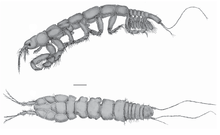Longiflagrum amphibium
| Longiflagrum amphibium | |
|---|---|
 | |
| Holotype (♀) of Longiflagrum amphibium. Top: lateral view. Bottom: dorsal view. Scale bar: 1 mm. | |
| Scientific classification | |
| Kingdom: | Animalia |
| Phylum: | Arthropoda |
| Subphylum: | Crustacea |
| Class: | Malacostraca |
| Order: | Tanaidacea |
| Family: | Parapseudidae |
| Genus: | Longiflagrum |
| Species: | L. amphibium |
| Binomial name | |
| Longiflagrum amphibium Stępień & Błażewicz-Paszkowycz, 2009[1] | |
Longiflagrum amphibium is an estuarine species of crustacean in the order Tanaidacea. It is known only from the type locality, which is the intertidal zone at Port Hedland, Northwestern Australia.[1]
Description
Longiflagrum amphibium can be distinguished from the other four species of the genus Longiflagrum by having the shortest flagellum in the antennule and by its oval pleopod basis.[1] The specific name amphibium is from the Latin for "amphibious". The name reflects the species' presence in the intertidal zone.[1]
Ecology
All five Longiflagrum species occur in shallow coastal habitats such as the intertidal zone, eelgrass beds and estuaries where the salinity fluctuates over the range 5–34 psu,[2][3] and they are a frequent and abundant element of the soft-bottom ecosystem.[1][2]
References
- 1 2 3 4 5 Anna Stępień & Magdalena Blazewicz-Paszkowycz (2009). Neil Bruce, ed. "Advances in the taxonomy and biogeography of Crustacea in the Southern Hemisphere". ZooKeys. 18 (special issue): 161–170. doi:10.3897/zookeys.18.154.
|chapter=ignored (help) - 1 2 Donald F. Boesch (1973). "Three new tanaids (Crustacea, Tanaidacea) from southern Queensland". Pacific Science. 27 (2): 168–188.
- ↑ Saowapa Angsupanich (2004). "A new species of Longiflagrum (Tanaidacea, Parapseudidae) from Songkhla Lagoon, Thailand". Crustaceana. 77 (7): 849–860. doi:10.1163/156854004774248726. JSTOR 20105764.
External links
 Data related to Longiflagrum amphibium at Wikispecies
Data related to Longiflagrum amphibium at Wikispecies